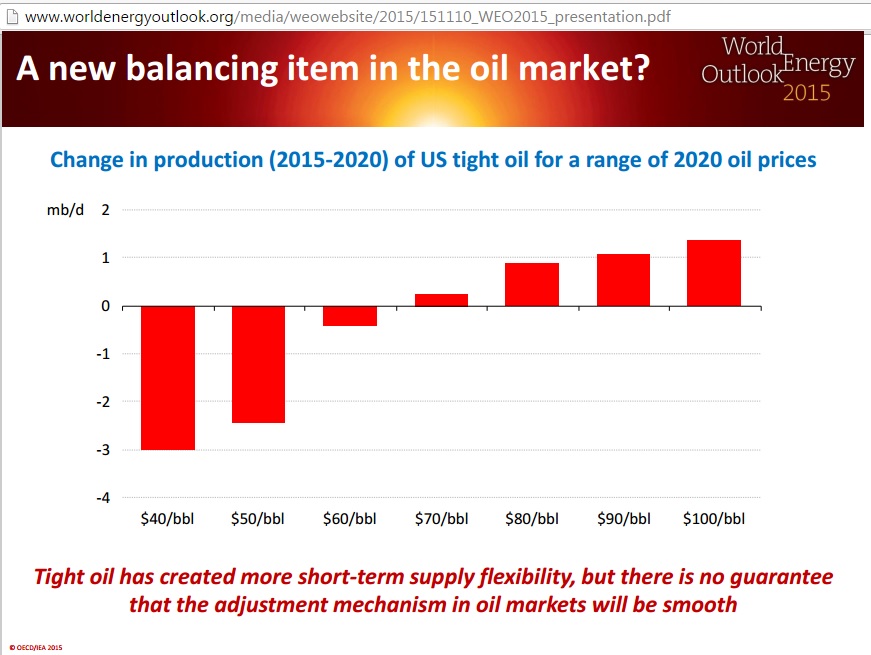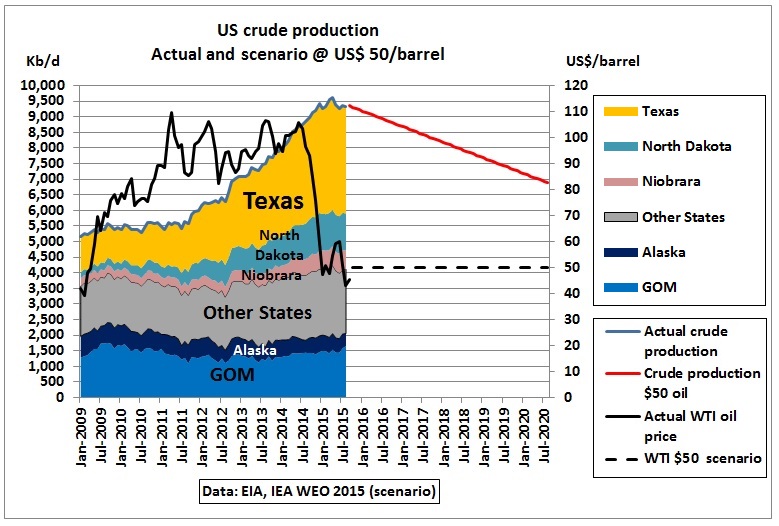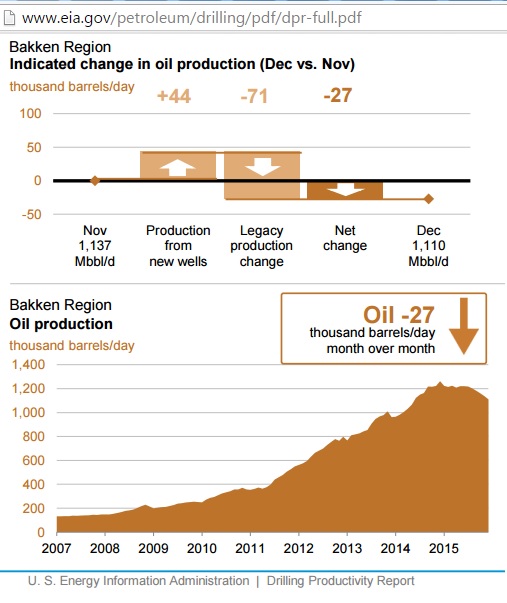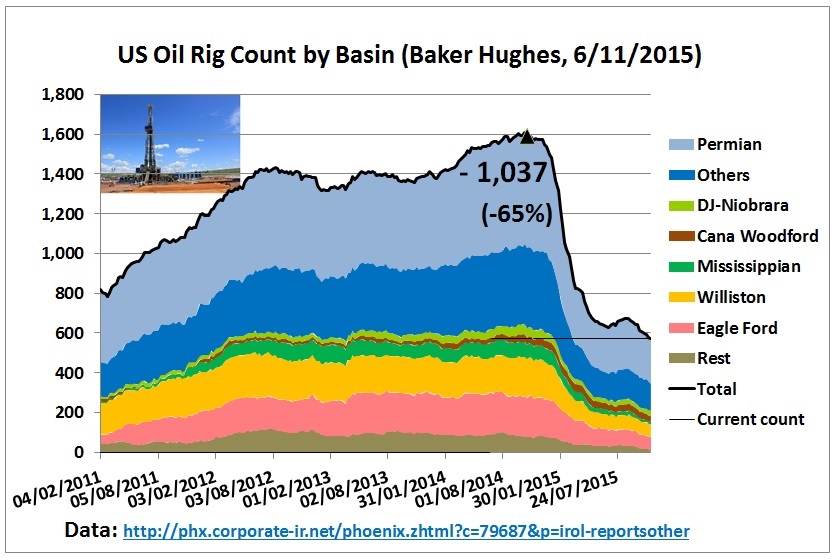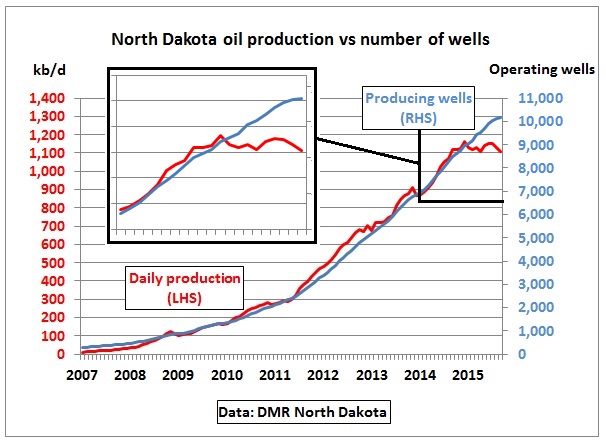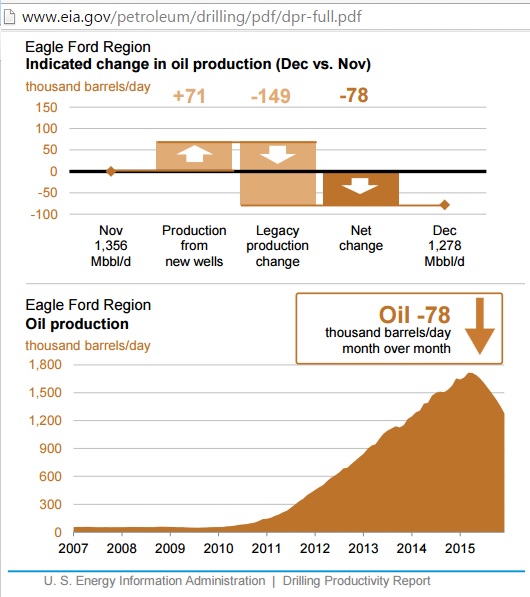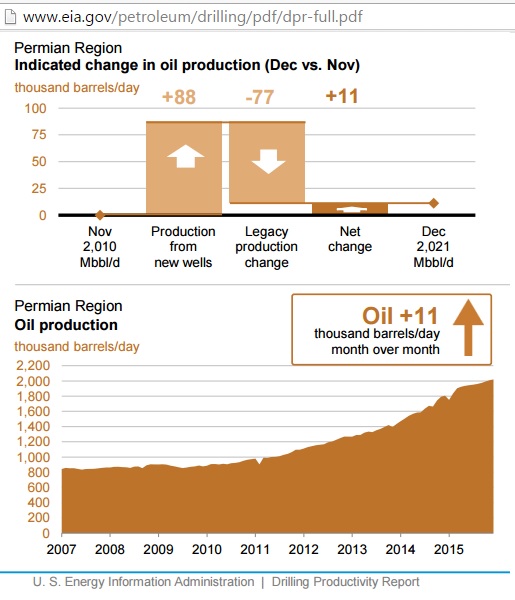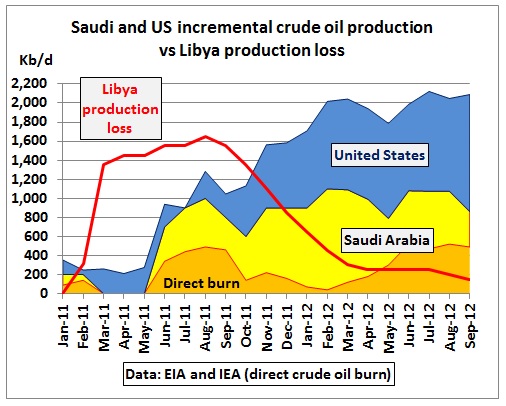You want $40 oil? Yes, please. But according to the World Energy Outlook 2015 of the International Energy Agency, recently released in London, that would mean 3 mb/d less US tight (shale) oil by 2020. That’s about 4% of global crude production.
Fly less and drive less.
Fig 1: Slide from the WEO 2015 presentation
Let’s put that into a graph for the $50 scenario:
Fig 2: US monthly crude production
The graph shows a 4 mb/d increase in US crude oil production, mainly tight oil from Texas (Eagle Ford, Permian), North Dakota (Bakken) and Niobrara (Colorado, Wyoming) between 2011 and 2015. The other States plus the Gulf of Mexico and Alaska remained on an undulating production plateau. The red production line descends by 2.5 mb/d over 5 years to 2020, with an oil price of $50 a barrel (dashed black line).
The EIA data for the above graph are from here:
Bakken
Fig 3: Bakken oil production (North Dakota)
Only 60% of natural decline (-71 kb/d per month) are offset by new production (44 kb/d) leading to a net decline of -27 kb/d in November 2015. The average decline in the last 5 months was around 20 kb/d per month or 240 kb/d pa. If that were to continue, production would be almost half by end 2017.
Fig 4: US oil rig count. Williston is Bakken
The focus is usually on the rig count but what finally matters are the number of oil wells and what they produce. And it’s not looking good. Despite an increase in wells, production doesn’t seem to go up and trends downward.
Fig 5: North Dakota oil production and operating oil wells
In November 2015 ND oil production was back to July 2014 levels (average of about 1.12 mb/d). In order to achieve this, the number of operating wells had to be increased by 2,000 from 8,000 to 10,000 or 25%. This shows on which treadmill the tight oil industry is riding on as a result of rampant decline in legacy wells. Data are from this file:
Niobrara
Fig 6: Niobrara oil production
At current decline rates, Niobrara oil production would be back to pre-tight oil levels by early 2017.
Eagle Ford
Fig 7: Eagle Ford oil production
On these steep declines, Eagle Ford would be approaching very low production levels by end 2017, mainly stripper wells.
Texas Permian
Fig 8: Permian oil production in Texas
This is more difficult to predict as the Permian contains also conventional oil. At present, oil production is still increasing but growth rates have been slowing in the last 3 months. Moreover, decline is 88% of new production so this net growth result is very vulnerable to changes. If growth were to continue this would deliver an extra 260 kb/d by end 2017. In an alternative scenario of a similar decline oil production could be down to 1.8 mb/d.
Let’s sum the production changes by end 2017
Bakken -600 kb/d
Niobrara -350 kb/d
Eagle Ford -1,500 kb/d
Permian +260 kb/d
Total -2.2 mb/d
Therefore, a production drop of -2.5 mb/d envisaged by the IEA for $50 oil in 2020 could already happen in 2018.
US not a swing producer
Note that in Fig 1 the IEA is using the term “New balancing item” and not “swing producer”. A swing producer is an oil producer who can
(a) – in response to unexpected disruptions elsewhere – increase oil production quickly (
within 30 days) until “sustainable spare capacity” is reached, if needed. In the US there is a crude oil export ban in place so any extra US oil will impact on global oil markets only indirectly via less US crude imports and more product exports, provided however that refineries can adapt and the US$ is not too high
(b) on the other hand, will also voluntarily reduce production when an economic or financial crisis results in stagnating or declining global demand.
The US cannot do (a) quickly and (b) happens painfully slow via lower oil prices – a phase in which we are now. Only a national oil company under government control can play such a dual role. But let’s see how Saudi Arabia and the US performed during the last test when the Arab Spring started in Libya:
Fig 9: Saudi and US production in response to Libya crisis
Saudi Arabia ramped up production with a delay of 3 months. But in the critical summer of 2011, around half of this increase was direct burn in power plants, so not available for export. Moreover, most of Saudi oil is not an ideal replacement for Libyan light oil. But the US tight oil would be similar to the Libyan oil. In 2010/2011, the US tight oil boom started, but not quickly enough to replace Libyan oil. Thus, a supply gap opened. No real swing producer there.
Next time there is a disruption the question would be: who can ramp up fast enough? If the Saudis are pumping at maximum, how fast could US tight oil be revived? How many US oil companies would have survived until then? Would banks have the confidence to finance a 2nd tight oil boom? Few governments would have an answer or even bother to think about it.
Iraq’s oil ante Galveston portas
Competition to US tight oil has re-emerged.
OPEC Challenges Shale Afresh as Iraq Crude Floods U.S. Market
11/11/2015
Iraq, the fastest-growing producer within the 12-nation group, loaded as many as 10 tankers in the past several weeks to deliver crude to U.S. ports in November, ship-tracking and charters compiled by Bloomberg show. Assuming they arrive as scheduled, the 19 million barrels being hauled would mark the biggest monthly influx from Iraq since June 2012, according to Energy Information Administration figures.
Fig 10: US crude imports from Iraq
Fig 11: Oil tanker jam in the Gulf of Mexico Nov 2015
Conclusion
When George Bush and Dick Cheney, themselves oilmen and fearful of peaking global oil production, tried to liberate Iraqi oil in 2003 they could not imagine what the consequences would be which we now see every day on TV, all over the world. The mission was not accomplished and high oil prices in 2008 almost killed the financial system which had a pre-condition of accumulated petro-dollar debt.
The US Federal Reserve saved the day in 2009 by raining helicopter money all over the place, thereby financing yet another bubble, the so-called US tight oil revolution. A national sport developed in the US to make this a success story with the noble objective to become independent from oil imports. But the oil market did not like being swamped with expensive tight and other oil. So when the Federal Reserve announced an end to helicopter flights the response was an oil price crash in 2014, challenging the US oil industry.
Coincidentally or not, Iraq finally manages to produce at least some of the oil Bush and Cheney had dreamed of. But in an ultimate irony of oil history it’s all coming at an inconvenient time. Will the Iraqi oil prick the US tight oil bubble? And what is the impact on the Iraqi budget? Is there a good end in sight? Prepare for some surprises and pain at the pump. If it doesn’t come, the world will be in recession.
Further reading from Arthur Berman
Only 1% of the Bakken Play Breaks Even at Current Oil Prices
Only 1% of the Bakken Play area is commercial at current oil prices. 4% of horizontal wells drilled since 2000 meet the EUR (estimated ultimate recovery) threshold needed to break even at current oil prices, drilling and completion, and operating costs.
The leading producing companies evaluated in this study are losing $11 to $38 on each barrel of oil that they produce, the very definition of waste.
Although NYMEX prices are about $46 per barrel, realized wellhead prices in the Bakken are only $30 per barrel according to the North Dakota Department of Mineral Resources. At that price, approximately 125,000 acres of the drilled play area of 10,500,000 acres is commercial.



